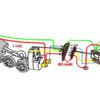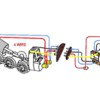Hello,
i just got my American Flyer 282 and 302 locomotives back from my brother from decades ago.
When I put the 282 on the track, the headlight will come on and smoke starts to come put of the smokestack, but the train will not move in either direction.
The 302 does not do anything.
The tender on both of them has a switch that moves and I have read that there is a 2 and a 4 position E unit in some tenders.
I am am hoping the 282 is just in neutral and that is why it is not moving.
Does any one know where I need to put the switch to make sure it is in forward or reverse?
I am using a new Lionel cw-80 transformer with this. Does that matter?
Any help would be greatly appreciated.
Thanks Ron.








